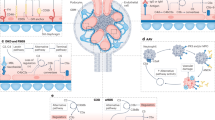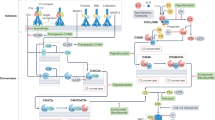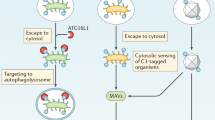Abstract
Complement activation is common in patients with systemic lupus erythematosus (SLE), resulting in hypocomplementemia and deposition of complement at sites of tissue damage. The availability of mice with specific deficiencies of components of the complement system has provided new insights into the mechanisms by which complement might be involved in autoimmunity and tissue injury in SLE. In humans, deficiencies of early components of the classical complement pathway are strongly associated with SLE. Mice lacking C1q or C4 are also predisposed to autoimmunity, which is associated with the failure of normal clearance of apoptotic cells bearing on their surfaces many of the autoantigens involved in SLE. Antiphospholipid syndrome is common in patients with SLE and studies in an animal model of fetal loss caused by antiphospholipid syndrome have shown that injury is dependent on activation of complement with subsequent neutrophil influx and synthesis of tumor necrosis factor. Insights from animal models might enable the design of more rational therapeutic approaches for manipulating the complement system in human SLE.
Key Points
-
Activation of the complement cascade in patients with systemic lupus erythematosus leads to hypocomplementemia and deposition of complement components at sites of tissue injury
-
Deficiencies of early components of the classical complement pathway are strongly associated with systemic lupus erythematosus in humans and autoimmunity in mice
-
Genetically manipulated mice that lack individual proteins of the complement system have provided insights into the role of complement in autoimmunity
-
In an animal model of fetal loss caused by antiphospholipid syndrome, injury is dependent on complement activation
-
Improved therapeutic approaches that manipulate the complement system in patients with systemic lupus erythematosus might soon be developed
This is a preview of subscription content, access via your institution
Access options
Subscribe to this journal
Receive 12 print issues and online access
$209.00 per year
only $17.42 per issue
Buy this article
- Purchase on Springer Link
- Instant access to full article PDF
Prices may be subject to local taxes which are calculated during checkout



Similar content being viewed by others
References
Walport MJ (2001) Complement. N Engl J Med 344: 1058–1066
Casciola-Rosen LA et al. (1994) Autoantigens targeted in systemic lupus erythematosus are clustered in two populations of surface structures on apoptotic keratinocytes. J Exp Med 179: 317–330
Mevorach D et al. (1998) Systemic exposure to irradiated apoptotic cells induces autoantibody production. J Exp Med 188: 387–392
Pickering MC and Walport MJ (2005) Links between complement abnormalities and systemic lupus erythematosus. Rheumatology 39: 133–141
Botto M et al. (1998) Homozygous C1q deficiency causes glomerulonephritis associated with multiple apoptotic bodies. Nat Genet 19: 56–59
Taylor PR et al. (2000) A hierarchical role for classical pathway complement components in the clearance of apoptotic cells in vivo. J Exp Med 192: 359–366
Chen Z et al. (2000) Complement C4 inhibits systemic autoimmunity through a mechanism independent of complement receptors CR1 and CR2. J Exp Med 192: 1339–1351
Ehrenstein MR et al. (2000) Deficiency in serum immunoglobulin (Ig)M predisposes to development of IgG autoantibodies. J Exp Med 191: 1253–1257
Cohen PL et al. (2002) Delayed apoptotic cell clearance and lupus-like autoimmunity in mice lacking the c-mer membrane tyrosine kinase. J Exp Med 196: 135–140
Napirei M et al. (2000) Features of systemic lupus erythematosus in Dnase1-deficient mice. Nat Genet 25: 177–181
Szondy Z et al. (2003) Transglutaminase 2−/− mice reveal a phagocytosis-associated crosstalk between macrophages and apoptotic cells. Proc Nat Acad Sci USA 100: 7812–7817
Hanayama R et al. (2004) Autoimmune disease and impaired uptake of apoptotic cells in MFG-E8-deficient mice. Science 304: 1147–1150
Herrmann M et al. (1998) Impaired phagocytosis of apoptotic material by monocyte-derived macrophages from patients with systemic lupus erythematosus. Arthritis Rheum 41: 1241–1250
Verbovetski I et al. (2002) Opsonization of apoptotic cells by autologous iC3b facilitates clearance by immature dendritic cells, down-regulates DR and CD86, and up-regulates CC chemokine receptor 7. J Exp Med 196: 1553–1561
Morelli AE et al. (2003) Internalization of circulating apoptotic cells by splenic marginal zone dendritic cells: dependence on complement receptors and effect on cytokine production. Blood 101: 611–620
Nauta AJ et al. (2004) Opsonization with C1q and mannose-binding lectin targets apoptotic cells to dendritic cells. J Immunol 173: 3044–3050
Carroll MC (2004) A protective role for innate immunity in systemic lupus erythematosus. Nat Rev Immunol 4: 825–831
Mitchell DA et al. (1999) C1q protects against development of glomerulonephritis independently of C3 activation. J Immunol 162: 5672–5679
Einav S et al. (2002) Complement C4 is protective for lupus disease independent of C3. J Immunol 168: 1036–1041
Clynes R et al. (1998) Uncoupling of immune complex formation and kidney damage in autoimmune glomerulonephritis. Science 279: 1052–1054
Matsumoto K et al. (2003) Fc receptor-independent development of autoimmune glomerulonephritis in lupus-prone MRL/lpr mice. Arthritis Rheum 48: 486–494
Sekine H et al. (2001) Complement component C3 is not required for full expression of immune complex glomerulonephritis in MRL/lpr mice. J Immunol 166: 6444–6451
Elliott MK et al. (2004) Effects of complement factor D deficiency on the renal disease of MRL/lpr mice. Kidney Int 65: 129–138
Wang Y et al. (1996) Amelioration of lupus-like autoimmune disease in NZB/W F1 mice after treatment with a blocking monoclonal antibody specific for complement component C5. Proc Natl Acad Sci USA 93: 8563–8568
Bao L et al. (2005) Signaling through up-regulated C3a receptor is key to the development of experimental lupus nephritis. J Immunol 175: 1947–1955
Bao L et al. (2005) C5a promotes development of experimental lupus nephritis which can be blocked with a specific receptor antagonist. Eur J Immunol 35: 2496–2506
Uwatoko S and Mannik M (1988) Low-molecular weight C1q-binding immunoglobulin G in patients with systemic lupus erythemtosus consists of autoantibodies to the collagen-like region of C1q. J Clin Invest 114: 616–619
Frémeaux-Bacchi V et al. (2002) No lupus nephritis in the absence of antiC1q antibodies. Nephrol Dial Transplant 17: 2041–2043
Trouw LA et al. (2004) Anti-C1q autoantibodies in murine lupus nephritis. Clin Exp Immunol 135: 41–48
Trouw LA et al. (2005) Anti-C1q autoantibodies deposit in glomeruli but are only pathogenic in combination with glomerular C1q-containing immune complexes. J Clin Invest 114: 679–688
Holers VM (2004) Anti-C1q autoantibodies amplify pathogenic complement activation in systemic lupus erythematosus. J Clin Invest 114: 616–619
Holers VM et al. (2002) Complement C3 activation is required for antiphospholipid antibody-induced fetal loss. J Exp Med 195: 211–220
Girardi G et al. (2003) Complement C5a receptors and neutrophils mediate fetal injury in the antiphospholipid syndrome. J Clin Invest 112: 1644–1654
Thurman JM et al. (2005) A novel inhibitor of the alternative complement pathway prevents antiphospholipid antibody-induced pregnancy loss in mice. Mol Immunol 42: 87–97
Berman J et al. (2005) TNF-α is a critical effector and a target for therapy in antiphospholipid antibody-induced pregnancy loss. J Immunol 174: 485–490
Girardi G et al. (2004) Heparin prevents antiphospholipid antibody-induced fetal loss by inhibiting complement activation. Nat Med 10: 1222–1226
Pierangeli SS et al. (2005) Requirement of activation of complement C3 and C5 for antiphospholipid antibody-mediated thrombophilia. Arthritis Rheum 52: 2120–2124
Ohlenschlaeger T et al. (2004) Mannose-binding lectin variant alleles and the risk of arterial thrombosis in systemic lupus erythematosus. N Engl J Med 351: 260–267
Garred P et al. (2001) Association of mannose-binding lectin gene variation with disease severity and infections in a population-based cohort of systemic lupus erythematosus patients. Genes Immunol 2: 442–450
Acknowledgements
The authors would like to thank the Wellcome Trust for supporting their research.
Author information
Authors and Affiliations
Corresponding author
Ethics declarations
Competing interests
The authors declare no competing financial interests.
Rights and permissions
About this article
Cite this article
Cook, H., Botto, M. Mechanisms of Disease: the complement system and the pathogenesis of systemic lupus erythematosus. Nat Rev Rheumatol 2, 330–337 (2006). https://doi.org/10.1038/ncprheum0191
Received:
Accepted:
Issue Date:
DOI: https://doi.org/10.1038/ncprheum0191
This article is cited by
-
Humoral and cellular response in convalescent COVID-19 lupus patients
Scientific Reports (2022)
-
Autoinflammation and autoimmunity across rheumatic and musculoskeletal diseases
Nature Reviews Rheumatology (2021)
-
Monocyte differentiation and macrophage priming are regulated differentially by pentraxins and their ligands
BMC Immunology (2017)
-
Serum TWEAK as a biomarker for disease activity of systemic lupus erythematosus
Inflammation Research (2016)
-
Up-regulation of Serum MiR-130b-3p Level is Associated with Renal Damage in Early Lupus Nephritis
Scientific Reports (2015)



